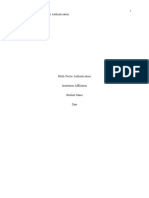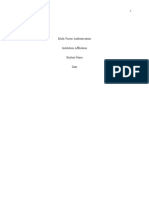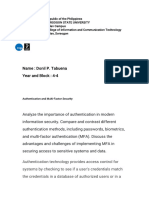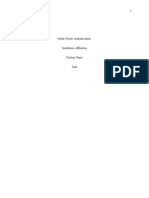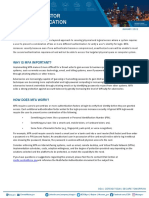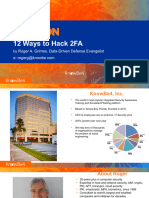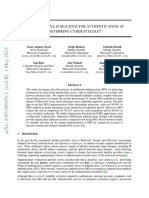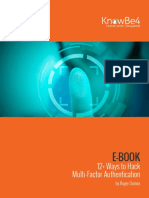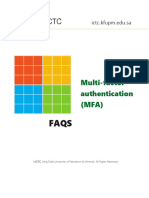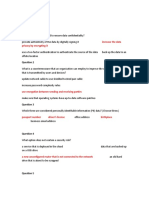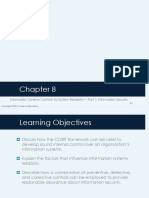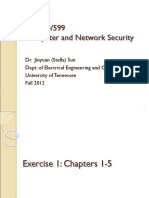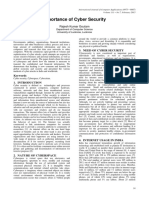Hackercombat.
com
�What is Multi-Factor
Authentication (MFA)
Multi-Factor Authentication (MFA) is a security mechanism that
requires users to provide two or more verification factors to gain
access to a resource, such as an application, online account, or
network. The primary goal of MFA is to create a layered defense,
making it significantly more difficult for unauthorized individuals to
access a system. Unlike traditional password-only authentication, MFA
combines something the user knows (like a password), something the
user has (such as a mobile phone or security token), and something the
user is (biometric verification like a fingerprint or facial recognition).
This multi-layered approach ensures that even if one factor is
compromised, the likelihood of an attacker successfully breaching the
account is greatly reduced.
For example, consider the process of logging into an online banking
account. With MFA enabled, after entering the correct password
(something you know), the system may send a verification code to your
mobile phone (something you have). You would then need to enter
this code to complete the login process. Some systems may also
employ biometric verification, such as a fingerprint scan (something
you are), adding an additional layer of security. This method not only
strengthens security but also mitigates the risk posed by common
threats such as phishing, where attackers may obtain a user's
password but are unlikely to have access to the second or third factor.
Hackercombat.com
�Types of
Multi-Factor
Authentication
(MFA)
�6 Types of Multi-Factor Authentication
What You Know
(Knowledge-Based)
This classic MFA method relies on information that
only the user should know. The most common
example is a password, a secret string of characters.
PINs (Personal Identification Numbers) are numerical
versions of passwords, often used for ATM cards and
mobile devices.
Security questions, which ask for personal details like
"What city were you born in?" or "What was your
childhood pet's name?", provide another layer of
knowledge-based authentication. The drawback is
that this information can be forgotten, guessed, or
stolen through phishing attacks.
Hackercombat.com
�6 Types of Multi-Factor Authentication
What You Have
(Possession-Based)
This method requires users to physically possess a
specific item to authenticate. A common example is a
hardware token, a small device generating one-time
passcodes (OTPs) that expire after a short time,
enhancing security against replay attacks.
Smartphones also function as possession factors,
receiving OTPs via SMS or through dedicated
authenticator apps for convenience. Security keys,
tiny USB devices, leverage cryptographic protocols
to verify user identity, offering strong protection.
While generally more secure than knowledge-based
factors, these physical tokens can be lost, stolen, or
damaged.
Hackercombat.com
�6 Types of Multi-Factor Authentication
What You Are
(Inherence-Based)
Inherence-based MFA leverages unique biological
characteristics for identification. Fingerprint scanning
captures the distinct ridge patterns of a user's
fingertip, matching them against a stored template.
Facial recognition analyzes facial features like the
distance between eyes or the shape of the nose for
verification. Iris scans capture the intricate patterns in
the colored part of the eye, providing a highly secure
but less common method. These biometric factors
are difficult to forge, but they require specialized
hardware and may raise privacy concerns for some
users.
Hackercombat.com
�6 Types of Multi-Factor Authentication
What You Do
(Pattern-Based)
This method focuses on analyzing the user's unique
behavioral patterns during authentication. This could
include the rhythm and speed of their typing on a
keyboard, the way they move a mouse, or even how
they hold and interact with a mobile device.
The underlying principle is that these patterns are
unique to individuals and difficult to imitate. Pattern-
based MFA can offer an additional layer of security,
but it may be less reliable as user behavior can
change over time or be affected by external factors.
Hackercombat.com
�6 Types of Multi-Factor Authentication
Where You Are
(Location-Based)
Location-based MFA verifies the user's physical or
network location during the authentication process.
GPS coordinates from a mobile device, IP address
information, or other geolocation technologies are
used to confirm that a login attempt originates from
an expected location.
This method can be useful for detecting
unauthorized access attempts from unusual or
unexpected geographical areas, but it can also be
susceptible to spoofing if not implemented carefully.
Hackercombat.com
�6 Types of Multi-Factor Authentication
When You Are
(Time-Based)
Time-based MFA introduces temporal restrictions
on access to systems or resources. It limits
authentication to specific timeframes or schedules,
based on the organization's security policies. This
method can be useful for enforcing access controls
outside of normal business hours or during periods
of heightened security risk.
Time-based MFA can add another layer of control
over access but requires careful management to
avoid locking out legitimate users due to time zone
differences or unexpected schedule changes.
Hackercombat.com
� Hackercombat.com
Was it helpful?
Like Comment Share Save




